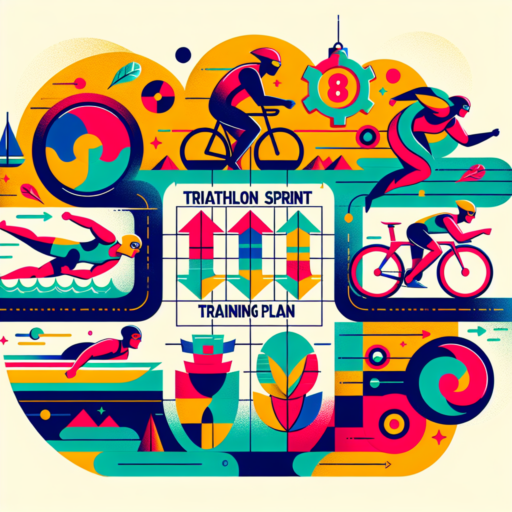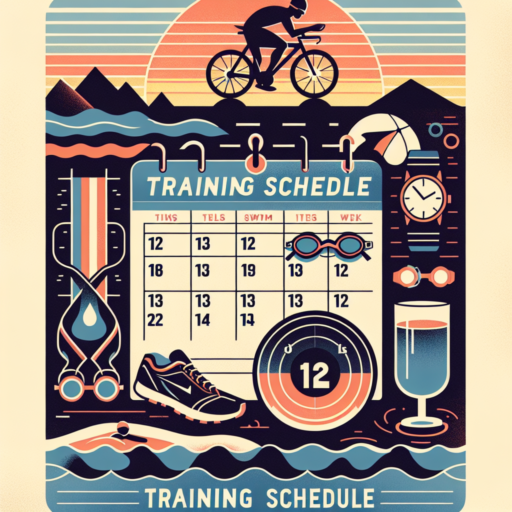Introduction to Triathlon Sprint Training: Preparing for Success in 8 Weeks
Embarking on a triathlon sprint journey embodies the pinnacle of challenging oneself across swimming, biking, and running. This intensive blend of disciplines necessitates a targeted and structured approach, especially when aiming for success in a condensed 8-week timeframe. For novices and veterans alike, understanding the foundational elements of triathlon sprint training is crucial. It’s not merely about training harder, but also smarter, ensuring each session propels you closer to your personal triumph.
Commencing your triathlon sprint training demands a well-rounded preparation strategy. Initially, it’s vital to establish a baseline in each of the three disciplines. This doesn’t mean excelling from day one but rather, recognizing your current capabilities and limitations. A balanced 8-week plan should incorporate progressive overload, skill refinement, and adequate recovery periods. Adaptation is key, allowing your body to gradually acclimate to the increased demands of training across three varied sports.
Key Components of a Triathlon Sprint Training Program
- Swimming: Focus on technique, endurance, and speed. Incorporate drills to enhance efficiency in the water.
- Cycling: Build endurance and power through interval training and longer, steady rides. Mastering bike handling skills is also essential.
- Running: Improve running form, efficiency, and pace. Include interval work and tempo runs to boost speed and endurance.
As you delve into your triathlon sprint preparation, the integration of these components within your training schedule is paramount. Balancing intensity and volume, alongside ensuring recovery, will forge a robust foundation, gearing you towards achieving your 8-week goal. Embrace the journey, for each step, pedal, and stroke is a stride towards your ultimate success in triathlon sprinting.
Week 1-2: Building a Solid Foundation for Your Triathlon Sprint Training Plan
Embarking on a triathlon sprint journey begins with the crucial steps of laying a strong foundation in the first two weeks of your training regimen. This initial phase is pivotal, as it prepares your body and mind for the intensive training ahead. Establishing a solid groundwork involves focusing on three core elements: endurance building, strength training, and skill refinement.
Endurance Building
In the early stages of your triathlon sprint training plan, gradually increasing your aerobic capacity is essential. Start with light, manageable exercises that include short swims, bikes, and runs. This approach not only boosts your endurance but also helps in preventing early burnouts or injuries. Emphasizing consistency over intensity during these weeks will set a robust foundation for more demanding workouts as your training progresses.
Strength Training
Complementing your endurance activities with strength training is a must for building a strong foundation. Focus on exercises that target the core muscles, as well as leg and arm strength. Incorporating bodyweight exercises, such as push-ups, pull-ups, and planks, can significantly enhance your triathlon performance by improving your overall strength and stability. Investing time in strength training during these initial weeks pays off by making you a more resilient and powerful athlete.
Skill Refinement
Lastly, the beginning of your triathlon training should include a focus on honing the technical skills required for swimming, cycling, and running. Proper technique is not only crucial for efficiency and speed but also for minimizing the risk of injuries. Assess and work on your form in each discipline, perhaps considering professional coaching or feedback. This period is ideal for correcting bad habits and solidifying good ones, ensuring a smoother and faster transition between events.
Week 3-4: Increasing Intensity and Endurance in Your Training
Entering weeks 3 and 4 of your training program presents the perfect opportunity to kick things up a notch. At this stage, your body has started adapting to the physical demands of exercise, making it the ideal time to increase both the intensity and endurance aspects of your workouts. The focus here is not just on doing more, but on challenging your body to improve your fitness levels significantly.
One effective method to ramp up the intensity is through interval training. Interval training involves short bursts of high-intensity exercises followed by periods of low-intensity activity or rest. This technique is not only efficient in building endurance but also in increasing cardiovascular fitness, leading to enhanced athletic performance. Furthermore, integrating interval training into your routine during weeks 3 and 4 can prevent your workouts from feeling monotonous, keeping your motivation levels high.
Increasing the duration of your workouts is another strategy for boosting endurance. Gradually extending your exercise sessions by a few minutes each week can greatly impact your stamina. It’s essential, however, to balance intensity with duration to prevent overtraining and injuries. By carefully planning your workouts to include a mix of both elements, you can achieve optimal results without compromising your health or wellbeing.
Week 5-6: Sharpening Your Skills in Swimming, Cycling, and Running
As you transition into Weeks 5 and 6 of your training program, it’s time to focus on refining your technique and increasing efficiency in your three core disciplines: swimming, cycling, and running. This phase will challenge your body and mind as you push towards mastering the fundamentals, optimizing your performances, and preparing for more advanced training sessions. Emphasizing skill improvement during these weeks is crucial for building endurance and preventing injuries.
In the realm of swimming, now is the opportune time to fine-tune your stroke efficiency. Concentrate on drills that enhance your body position, reduce drag in the water, and improve your breathing technique. Embracing these adjustments will not only increase your propulsion but also conserve your energy for the later stages of your race. Additionally, incorporating interval training can help build stamina and speed, vital components for a strong swimming segment in any triathlon.
As for cycling, the focus shifts towards optimizing your pedaling technique and bike handling skills. Sessions dedicated to high-intensity interval training (HIIT) will bolster your aerobic capacity, while hill repeats will build the leg strength necessary for tough climbs. Equally important is practicing in different terrains and conditions to become a more adaptable and resilient cyclist. This is also an ideal time to ensure your bike fit is perfect, as a well-adjusted bike can significantly reduce fatigue and the risk of injuries.
Lastly, running, the final segment of your triathlon, requires attention to pacing and form. Utilize tempo runs to get comfortable with holding a consistent pace over distance, and incorporate hill sprints to improve your power and speed. Remember, maintaining a relaxed yet efficient running form can drastically reduce your energy expenditure, allowing you to finish strong.
Week 7: Tapering and Recovery Strategies Before the Race
As race day approaches, understanding the importance of tapering and recovery strategies during Week 7 is crucial for runners. Tapering is the process of reducing training volume and intensity, giving your body the rest it needs to perform optimally on race day. This strategic reduction is not about halting training but adjusting it to maximize the body’s recovery and energy reserves. The right tapering method can make a significant difference in your race performance, mitigating fatigue and reducing the risk of injury.
Engaging in effective recovery techniques is equally important during this phase. Recovery isn’t merely about taking time off; it involves active strategies to ensure your muscles and cardiovascular system recover from the weeks of intense training, preparing them for the demands of the race. Incorporating activities such as light jogging, stretching, and foam rolling can facilitate muscle repair and maintain circulation, aiding in quicker recovery.
Hydration and nutrition play pivotal roles in the tapering period as well. Opt for a diet rich in carbohydrates, proteins, and fats to fuel your body and support muscle recovery. Staying hydrated is vital to maintain optimal physiological functions and aid in the recovery process. Emphasize the intake of water and electrolytes to replenish what is lost during lighter training sessions. Listen to your body during this crucial time, allowing it to guide your recovery and tapering efforts for the best race outcome.
No se han encontrado productos.
Week 8: Final Preparations and What to Expect on Race Day
As you approach Week 8, the culmination of your training is just around the corner. This crucial time is not just about maintaining your regimen but also about making final adjustments to ensure you’re as prepared as possible for race day. Understanding what to expect and how to fine-tune your preparations can significantly impact your performance and overall experience.
During this final week, your focus should shift towards tapering and resting. It’s essential to reduce the mileage and intensity of your workouts to allow your body to recover and store energy for the big day. Even more, consideration should be given to nutrition and hydration strategies. Loading your body with the right fuels can make a significant difference in your stamina and endurance. Hydration, too, plays a crucial role and should not be underestimated in the days leading up to and on race day itself.
Understanding what awaits you on race day is another key factor in your final preparations. Familiarize yourself with the course map, start time, weather forecast, and any rules or instructions provided by the organizers. This knowledge will help you strategize your race, from pacing yourself correctly to wearing suitable clothing. Remember, preparing for the mental challenge is just as important. Visualizing the course and your race strategy can help ease anxieties and boost your confidence as you toe the line.
Nutrition and Hydration Tips for Triathlon Sprint Training
Embarking on a triathlon sprint training journey not only requires a formidable physical regimen but also demands an astute consideration for nutrition and hydration. These two elements are pivotal in ensuring that athletes can perform at their peak while minimizing the risk of injury and fatigue. Understanding what your body needs before, during, and after training can make a significant difference in your overall performance and recovery.
Pre-Training Nutrition and Hydration
Before you lace up your sneakers, it’s essential to fuel your body with the right nutrients and fluids. A focus on carbohydrates is crucial, as they are your body’s primary energy source. Incorporate a meal rich in complex carbohydrates, such as whole grains or fruits, 2-3 hours before your training. Hydrating well in advance is also key, aiming for at least 16-20 ounces of water a few hours before starting. This pre-training regime ensures that you begin your session fully fueled and hydrated.
During Training Hydration and Snacks
Hydration is your main ally during strenuous sessions. Sipping on water or an electrolyte-rich sports drink every 15-20 minutes helps maintain optimal performance levels and prevent dehydration. For training sessions extending beyond an hour, incorporating small, easily digestible snacks, like gels or a banana, can provide a quick energy boost. Furthermore, these snacks can help maintain your glucose levels and stave off fatigue.
Injury Prevention and Recovery Techniques During Your 8 Week Training Plan
Embarking on an 8-week training plan can significantly enhance your physical fitness, but it’s vital to approach it with a strategic mindset focused on injury prevention and recovery. Implementing effective techniques to avoid injuries and foster recovery is crucial for sustaining your progress and overall well-being throughout this period. Let’s delve into some essential strategies to keep in mind.
Essential Injury Prevention Strategies
Preventing injuries is the first step in ensuring a successful training journey. Incorporating a comprehensive warm-up routine before each session prepares your body for the physical stress it’s about to endure, significantly reducing the risk of injuries. Additionally, prioritizing proper form over the intensity or volume of your exercises is crucial; a misstep in technique can lead to unnecessary strain and potential injuries. Lastly, integrating strength training, particularly exercises that target the core and stabilizer muscles, can provide the support your body needs to handle the demands of your training regimen.
Recovery Techniques to Incorporate
Equally important to preventing injuries is fostering a robust recovery process. Integrating active recovery days into your plan allows your body to heal and adapt without bringing your training to a halt. Techniques such as yoga or light jogging can keep the blood flowing while aiding in muscle recovery and flexibility. Additionally, ensuring adequate sleep and nutrition are foundational elements of recovery. Prioritizing these can speed up your recovery times and bolster your body’s resilience against injuries.
Essential Gear and Equipment for Triathlon Sprint Success
Triathlon sprints, a condensed version of traditional triathlons, demand not only intense training but also precise selection of gear and equipment. To excel in each segment—swimming, biking, and running—athletes need to equip themselves with tools that enhance performance, flexibility, and comfort. Understanding the criticality of each piece of gear is paramount in crossing the finish line with success.
For the swim segment, a high-quality wetsuit is indispensable for those racing in colder waters. It provides buoyancy, reduces drag, and keeps the athlete warm, thus conserving energy for subsequent stages. Equally important are goggles that offer clear vision and a comfortable fit, as well as a swim cap that reduces resistance through the water. Selecting these items with care can significantly impact your swim time and overall comfort.
Moving onto the bike segment, the importance of a properly fitted and lightweight bike cannot be overstated. It should be tailored to the athlete’s body to ensure maximum efficiency and minimal strain. Aerodynamic helmets and speed suits further contribute to cutting down air resistance, while clipless pedals and cycling shoes enhance the transfer of power from athlete to machine. These advancements in gear not only improve performance but also provide safety and comfort during the longest phase of the race.
Measuring Progress and Adjusting Your Triathlon Sprint Training Plan
Embarking on a comprehensive triathlon sprint training program is the first step towards achieving your performance goals. However, the true essence of success in such an endeavor lies not just in following a predetermined plan, but also in the rigorous evaluation and enhancement of your training strategies over time. Measuring progress and making necessary adjustments is crucial for maximizing performance and achieving your desired results.
Measuring progress in your triathlon sprint training involves a multifaceted approach. First and foremost, tracking your workout metrics can provide insight into your endurance, speed, and efficiency across swimming, cycling, and running. Employing tools such as GPS watches, heart rate monitors, and power meters can offer valuable data that helps in understanding your improvements over time. Additionally, performing regular fitness assessments or time trials can serve as benchmarks for tracking your progress and identifying areas needing improvement.
Adjusting your triathlon sprint training plan based on the insights gained from measuring your progress is essential for continuous improvement. If you’re noticing plateaus or declines in particular areas, it’s a signal that your current training regimen may require tweaks. For instance, you may need to integrate more strength training to enhance muscle endurance, or incorporate higher intensity interval workouts to boost cardiovascular efficiency. Listening to your body and being willing to adapt your plan accordingly will keep your training effective and engaging.




